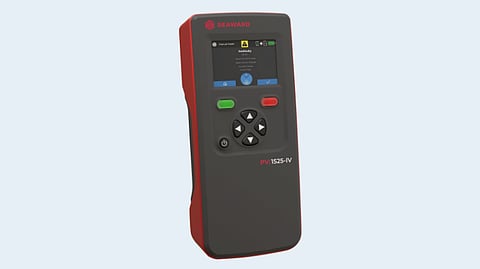

Key takeaways:
PV:1525-IV by Seaward Electronic is a handheld testing tool designed to support diagnostic measurements on PV systems up to 1,500 V DC
The built-in Bluetooth functionality enables storage and transfer of test data to external applications
Additional functions include manual and automated test modes, as well as input protection features
Seaward Electronic Ltd, based in the UK, develops handheld tools used by professionals working in the installation, maintenance, and inspection of solar photovoltaic (PV) systems. One of its products, the PV:1525-IV, was recently named a finalist in the Photovoltaics category of The smarter E AWARD 2025.
This portable testing device is designed for PV systems operating in the range of 1,500 V DC and 25 A. It can be used to measure open-circuit voltage (Voc), short-circuit current (Isc), insulation resistance, and earth continuity. It also includes I-V curve tracing, which captures the current-voltage characteristics of PV modules and strings. According to the company, these measurements help accurately identify power derating, cabling faults, and module degradation in a system. The company states that these measurements can be integrated into maintenance protocols and the results can be exported to the maintenance system with help of the built-in Bluetooth connectivity for further analysis.
The product seems to have been built on the similar product platform of the company, PV:1525. Both the products are powered by rechargeable batteries and are capable of storing up to 1,000 test results, which can be transferred to a mobile app via Bluetooth.
In addition to the IV curve analyses, other notable updates with the latest PV:1525-IV are addons of few safety-oriented features. These include input protection and visual alerts when connection errors are detected. It supports both automated and manual test modes, making it usable for quick performance checks or more detailed system diagnostics. The tool is compatible with several accessories, such as current clamps, irradiance sensors, and PV test leads, which help ensure more accurate readings and environmental data collection during fieldwork.
.png?w=50&fm=png)